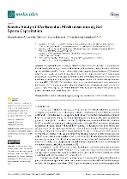Kinetic Study of 17α-Estradiol Mechanism during Rat Sperm Capacitation

Publication date
2022Published in
MoleculesVolume / Issue
27 (13)ISBN / ISSN
ISSN: 1420-3049Metadata
Show full item recordCollections
This publication has a published version with DOI 10.3390/molecules27134092
Abstract
17α-Estradiol (αE2) is a natural diastereoisomer of 17β-estradiol (E2). It is well known that αE2 can bind to estrogen receptors. However, its biological activity is less than that of E2 and is species and tissue specific. The goal of our study was to propose the mechanism of αE2 hormonal response in rat sperm during their capacitation in vitro and compare it with a previously studied mouse model. Concentration changes in externally added αE2 during capacitation of rat sperm were monitored by the high-performance liquid chromatographic method with tandem mass spectrometric detection (HPLC-MS/MS). The calculated values of relative concentrations B(t) were subjected to kinetic analysis. The findings indicated that αE2 in rat sperm did not trigger autocatalytic reaction, in contrast to the mouse sperm, and that the initiation of the hormone penetration through the sperm plasma membrane was substantially faster in rats.
Keywords
17α-estradiol, estrogen receptors, rat, sperm, capacitation, HPLC MS/MS, kinetics
Permanent link
https://hdl.handle.net/20.500.14178/1628License
Full text of this result is licensed under: Creative Commons Uveďte původ 4.0 International







